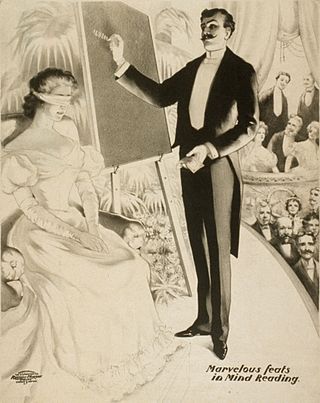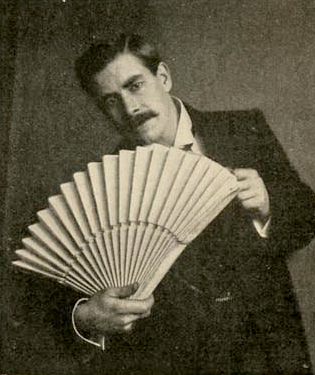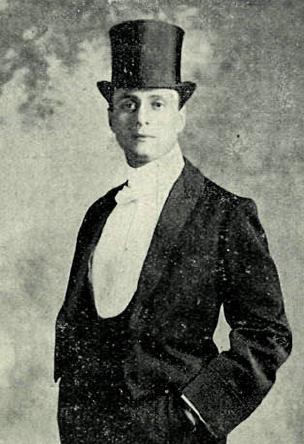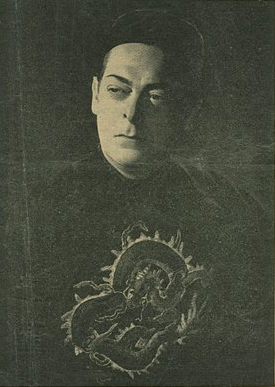
In theatrical magic, misdirection is a form of deception in which the performer draws audience attention to one thing to distract it from another. Managing audience attention is the aim of all theater, and the foremost requirement of all magic acts. Whether the magic is of a "pocket trick" variety or a large stage production, misdirection is the central secret. The term describes either the effect or the sleight of hand or patter that creates it.

Mentalism is a performing art in which its practitioners, known as mentalists, appear to demonstrate highly developed mental or intuitive abilities. Performances may appear to include hypnosis, telepathy, clairvoyance, divination, precognition, psychokinesis, mediumship, mind control, memory feats, deduction, and rapid mathematics. Mentalists perform a theatrical act that includes special effects that may appear to employ psychic or supernatural forces but that are actually achieved by "ordinary conjuring means", natural human abilities, and an in-depth understanding of key principles from human psychology or other behavioral sciences.

Cardistry is the performance art of card flourishing. Unlike card magic, cardistry is meant to be visually impressive and appear very hard to execute.

Shadow play, also known as shadow puppetry, is an ancient form of storytelling and entertainment which uses flat articulated cut-out figures which are held between a source of light and a translucent screen or scrim. The cut-out shapes of the puppets sometimes include translucent color or other types of detailing. Various effects can be achieved by moving both the puppets and the light source. A talented puppeteer can make the figures appear to walk, dance, fight, nod and laugh.

Street magic falls into two genres; traditional street performance and guerrilla magic.

David Devant was an English magician, shadowgraphist and film exhibitor. He was born David Wighton in Holloway, London. He is regarded by magicians as a consummate exponent of suave and witty presentation of stage illusion. According to magic historian Jim Steinmeyer, Devant was “England’s greatest magician—arguably the greatest magician of the 20th Century”.
Tobias "Theo" Leendert Bamberg (1875–1963) was a professional magician. Born in the Netherlands, Bamberg performed under the name Okito which is an anagram of Tokio (Tokyo). His father had been court magician to King William III of the Netherlands, making Okito the sixth generation in a family of outstanding magicians known as the Bamberg Magical Dynasty.
Troublewit is a specially pleated paper used for entertainment purposes. The paper is used to form various items, such as hats, fans and umbrellas by stage entertainers and illusionists.

Conjuring is an illustrated book about conjuring, or magic, by James "The Amazing" Randi, who himself was a magician and escape artist. Drawing on his extensive knowledge and experience in the field, Randi offers a series of brief biographies of a variety of noteworthy magicians and their unique styles, including Harry Houdini, Chung Ling Soo, Harry Blackstone Sr., Harry Blackstone Jr., Howard Thurston, and many others. He also provides an overview of several genres of magic such as stage magic, escapology, and mentalism, and of specific tricks such as the bullet catch. Reviews of the book were mainly positive.

Albert Almoznino was an Israeli hand shadow artist. He gained international recognition in the years 1958-1975 when he performed his hand shadow skills in front of thousands of people at Radio City Music Hall New York, Paris Olympia, Reno Nevada, "The Ed Sullivan Show" and other places.

Will Goldston (1878–1948) was an English stage magician in the first half of the 20th century.

Chink-a-chink is a simple close-up magic coin trick in which a variety of small objects, usually four, appear to magically transport themselves from location to location when covered by the performer's hands, until the items end up gathered together in the same place. Variations, especially the Sympathetic Coins also known as Coins-n-Cards, have been performed since the 1800s. Popular modern variations are Shadow Coins and Matrix. A variation using playing cards as the objects is known as Sympathetic Aces.

Félicien Trewey, born Félicien-François Trevey, was a French magician, mime, comedian, vaudevillian, tightrope walker, balance artist, dancer, musician, chapeaugraphist and shadowgraphist. The principal of Trewey's entertainment was balancing tricks, which at the time he was a grand master. He was a great card-thrower, scaling cards at great distances. He gave musical entertainment with instruments of his own invention. He had great skill in the uncommon art of writing any words selected by his audience backwards and was an exceptional lightning sketch artist. King Edward VII had witnessed Trewey on many occasions and the Emperor of Austria, Baron Rothschild, as well as many others, have on more than one occasion sent for him to come perform for them. He has also played in several films directed by his good friend Louis Lumière of The Lumière Brothers, including Chapeaux a Transformations (1895), The Photographe (1895), Danseuses des rues (1896), and was uncredited in the 1895 film Partie de cartes.

William Ellis Stanyon was a professional magician and magic dealer in London.

William Holden Maxwell was a Scottish-born American vaudeville performance artist and magician.
The Bamberg Magical Dynasty were a Dutch family of magicians, consisting of six generations of Bambergs. The Bambergs were an upper middle-class unorthodox Jewish family. Three Bambergs were court magicians who entertained the Dutch royal family, and many of the Bambergs were also trained actors. This chain was unbroken for 165 years, from the 18th to the 20th centuries.

David Tobias "Theodore" Bamberg was an itinerant magician who traveled with his full evening magic show from the early to mid part of the 20th century. In Bamberg's autobiography, Robert Parrish wrote in the introduction that no other great illusionist could match Bamberg's skill. The Fu Manchu show was known for its comedy, drama, and color.

Magic, which encompasses the subgenres of illusion, stage magic, and close-up magic, among others, is a performing art in which audiences are entertained by tricks, effects, or illusions of seemingly impossible feats, using natural means. It is to be distinguished from paranormal magic which are effects claimed to be created through supernatural means. It is one of the oldest performing arts in the world.

A projector or image projector is an optical device that projects an image onto a surface, commonly a projection screen. Most projectors create an image by shining a light through a small transparent lens, but some newer types of projectors can project the image directly, by using lasers. A virtual retinal display, or retinal projector, is a projector that projects an image directly on the retina instead of using an external projection screen.
François Dominique Séraphin was a French entertainer who developed and popularised shadow plays in France. The art form would go on to be copied across Europe.
















